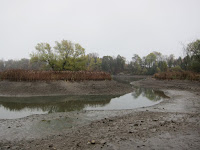Office Light Render
This week we completed our office renders by adding light to the scene. To create the lighting in this scene I used the multiply filter, overlay filter, dodge and burn tools, and Gaussian blurs.Before:

After:

Panoramic Project
My panorama (Click for larger view)
This week we studied unity and balance and our assignment was to create a panorama using a camera and Photoshop that incorporates symmetric balance.
In order to create my panorama, I took 13 pictures in total. I found this location on the Chapman Mills walking trail. The water level is very low, exposing the river floor and allowing me to take this awesome panorama.
Source images below (downsized):













After putting them together in photoshop using the automate > photomerge feature, using the adaptive wide lens tool to correct distortion and then cropping, I created this panorama:

I took the pictures on a rainy day so the colors looked somewhat dreary, but I used various filters, effects, and masks to make the image pop more. I used replace color to make the red of the cattails and the green of the trees more saturated, then used a vibrance filter and increased the vibrancy of the entire image. I also made the image brighter and raised the contrast of the ground so that it had more texture and was more of yellowy brown color. I then used sharpen to bring out more details in the ground and on the island, and then used a slight blur on objects that were farther away.
Finally!

Elements of Rhythm:
Flowing Rhythm: Island, Water, Wet Ground, Ground, Outer foliage.

The island, water, wet ground, ground, and outer foliage create a flowing rhythm because they make curved shapes that are repeated and create a sense of movement. They cause your eye to first look at the island, but be pushed outwards away from the island. This kind of flowing rhythm where your eye is pushed outwards away from an 'island' reminded me a lot of Japanese rock gardens:
(Image from http://www.newsjardintv.com/histoires-des-jardins/JARDINS-JAPONAIS-LE-DESIGN-DU-NATUREL.html)
Repetitive Rhythm: Cattails and Weeds

The cattails and weeds in this panorama are the best example of repetitive rhythm, because the cattails and weeds occur regularly, with little variation. For the most part, their vertical stems create an easy pattern to anticipate.
I think that the combination of symmetric balance, flowing rhythm and repetitive rhythm caused cattails, the scene has a 'xen' and 'perfect' look to it.
Random Rhythm: Shoreline of pebbles

Another example of rhythm in this photo is random rhythm, where the best example of this is the rocky shoreline.
Asymmetric Image and Ad
I then cropped the image to create the asymmetric version seen below. I decided to use this version of the image to make a pro-Ontario wildlife/ecosystem ad because I thought that it matched the photo.
The Ad:


Honorable mentions
These are other panoramas I created at the Chapman mills trail and Strandherd bridge.
Wooden deck Worm's eye:

Choose your destiny:

Awesome river scene:

Feeling 'under the bridge'!:
























